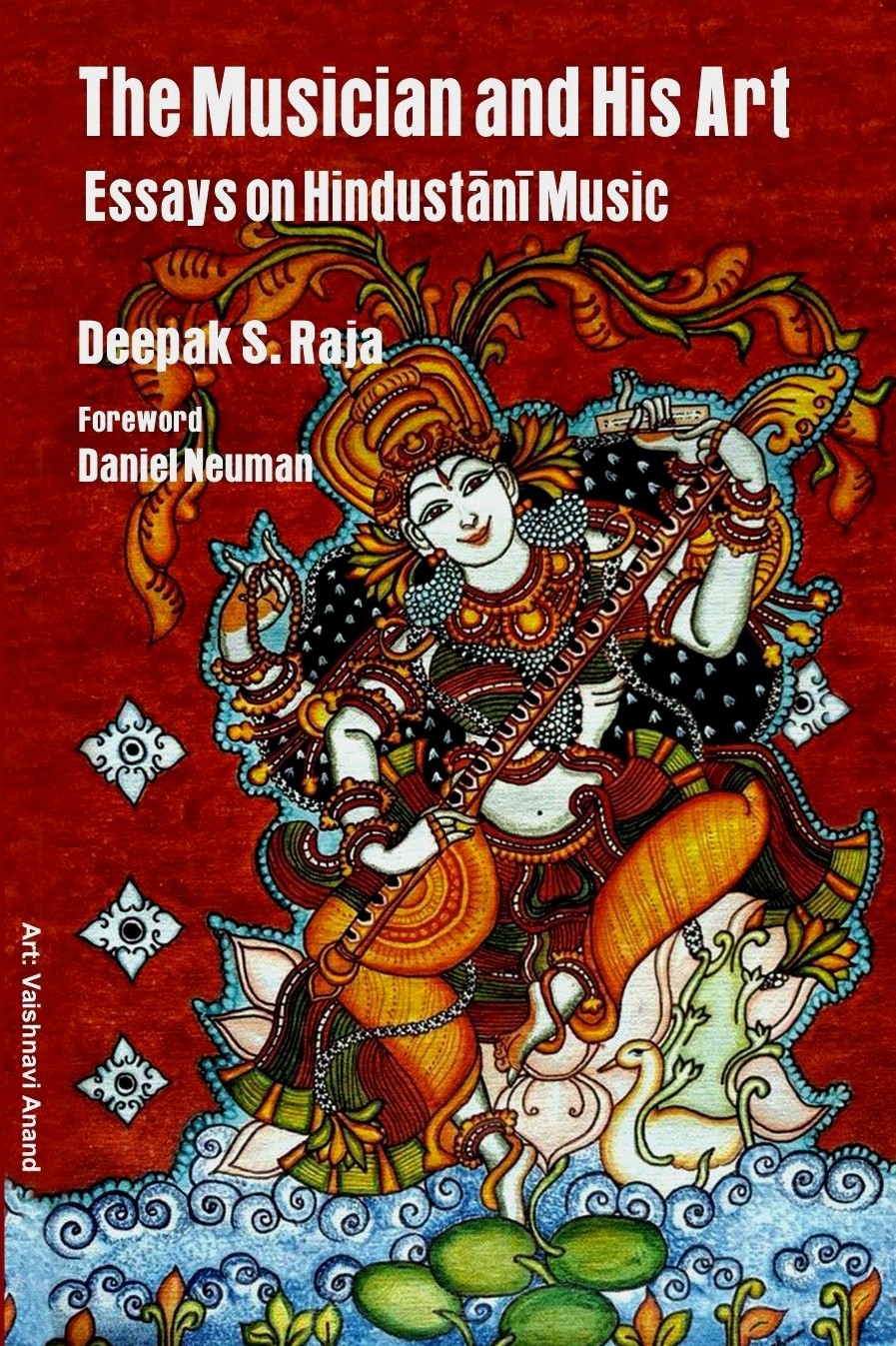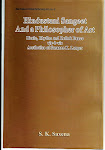Vachaspati is a Carnatic raga, representing the Vachaspati parent-scale (64th Melakarta). In its Hindustani adaptation, it has the tone material of raga Yaman with a flat (komal) Ni replacing the natural (shuddha).
Ascent: S R G M^ P D n S' Descent: S' n D P M^ G R S
By Hindustani raga grammar, this has been interpreted as the Kalyan parent-scale in the lower tetrachord and the Kafi parent-scale in the upper tetrachord. For Hindustani musicians, Yaman is the most logical reference point for Vachaspati because, strictly in scalar terms, replacing the Shuddha NI of Yaman with a Komal Ni delivers the Vachaspati scale. But, the issue is a little more complicated.
The most important aspect of the Yaman-to-Vachaspati transformation is the disappearance of the Ga-Ni axis in first-fifth correspondence. Without the Shuddha Ni, the new raga has to find an alternative axis to revolve around. The treatment of the raga by Hindustani musicians tends to explore several alternatives [Re-Pa, Ga-Dh and Ma^-ni], without being able to settle down with any of them. Such experimental uncertainty is evident in the Vachaspati renderings of musicians of even great stature, as it reflects the current stage of evolution of the raga in the Hindustani system.
From readily available references, it appears that Pandit Ravi Shankar's interpretation of Vachaspati is academic, precisely according to its scale. He does not omit Re and Dh in the ascent, as some Hindustani musicians have tended to do. As a result, the lower tetrachord remains close to the Yaman, and the upper tetrachord avoids proximity to the Gawoti/ Kalavati flavour. The melodic centre of gravity remains in the mid-octave region, where the two scales coalesce. Interestingly, and probably to accommodate a suggestion of the Carnatic style intonation, Panditji occasionally uses a subliminal touch of flat (komal) Ga along with the natural (shuddha) Ga and natural (shuddha) Ni along with Sa.
Pandit Shivkumar Sharma (Santoor.EMI/HMV: STCS:04B:7375) omits the Re tone in the ascent and frequently omits the sharp (tivra) Ma from the descent. (Ascent: S-G-M^-P-D-n-S' Descent: S'-n-D-P-M^-G-R-S or S'-n-D-P-G-R-S). Vocalist, Jagdish Prasad (unpublished) omits Re as well as Dh from the ascent (Ascent: S-G-M^-P-n-S' Descent: S'-n-D-P-M^-G-R-S.
The legendary Ustad Ameer Khan, who too had a penchant for Carnatic ragas (e.g. Hansadhwani, Charukeshi, Basant Mukhari/ Vakulabharanam), recorded an untitled and self-composed raga (INRECO:LP: 2411-0001,1982), which appears to be his interpretation of Vachaspati. Why he left it untitled is a mystery. In this raga, he omits Re and Dh from the ascent, and Dh from the descent. (Ascent: S-G-M^-P-n-S' Descent: S-n-P-M^-G-R-S). Ustad Ameer Khan's treatment of the Re tone in the descent is fleeting or summary.
Amarnath Mishra, a Benares based sitarist, trained by a leading Sarangi exponent, (published by India Archive Music, New York) conforms to the version which omits Re in the ascent. In addition, Mishra uses melodic features of Saraswati, an allied raga which includes Re, but omits Ga in the ascent and descent (Tone material: S R M^ P D n). Mishra's inclusion of phrases such as S-R-M^-R and S-R-M^-P, along with the characteristic M^-P-M^-R, incorporates the Saraswati identity. (For Saraswati: textual reference: Subba Rao B, Raga Nidhi, Vol. IV. 4th impression.1996 Music Academy, Madras. Pg.68.)
Vachaspati is increasingly becoming familiar to Hindustani audiences by its chalan (distinctive phraseology). This chalan itself is fluid because of the recency of the raga's introduction into Hindustani music and the handful of musicians of stature who have worked on shaping its distinctive melodic identity. The variance extends to the predominant mood of the raga, with renditions ranging from the profound to the vivacious and, of course, some which oscillate in between.
The transformation of Carnatic ragas into Hindustani melodic entities has been an uneven process. While some ragas like Abhogi, Hamsadhwani, and Kirwani have acquired a stable Hindustani identity reasonably fast, several others are unstable several decades after their introduction. Under such conditions, every musician playing these ragas risks confusion in the audience mind by calling his interpretation by the same Carnatic name. In addition, he also risks the disapproval of those Carnatic-oriented audiences, who might find themselves uncomfortable with all Hindustani treatments in general.
Chandni Kalyan -- an alternative name
This assessment of the risks probably persuaded Ustad Vilayat Khan, in the 1970s, to coin a new name “Chandni Kalyan” for Vachaspati. The word “Kalyan” establishes the raga’s anchoring in the Kalyan parent scale, and its affinity to Yaman, the main raga of the Kalyan scale. The prefix “Chandni” alludes to the precedent of Chandni Kedar which comes into being by replacing the Shuddha Ni of Kedar with a Komal Ni. Yaman Kalyan undergoes an identical transformation in Chandni Kalyan. The prefix was, therefore, considered appropriate.
Though Vachaspati is known to a large number of music lovers, familiarity with the Chandni Kalyan coinage is still restricted to Ustad Vilayat Khan’s audiences. Its logic could, however, assure wider usage for the name, if the raga itself becomes more popular.
Musicologists have often argued that Hindustani music tends to adopt merely the scales of Carnatic ragas, without concerning itself with the totality of their raga-ness. The musical approaches of the two traditions are so distinct that a cross-cultural transformation acceptable to both traditions may be impossible. The Hindustani tradition does, however, attempt to achieve a stable melodic personality for each adopted raga which may, or may not, appear satisfactory to aficionados of Carnatic music. The maturation of these personalities requires several musicians of great stature to devote their musical energies to the process. Until this happens, Hindustani as well as Carnatic audiences will perceive these transformations as awkward in their raga-ness.
Chandni Kalyan/ Vachaspati might still be at this half-baked stage of raga-ness in the Hindustani tradition. Its authoritative grammar will be written only after its literature has matured. Until then, each musician’s interpretation of it must be accepted on its own terms, and judged only on its distinctiveness and aesthetic coherence.
(c) India Archive Music Ltd. New York
Ascent: S R G M^ P D n S' Descent: S' n D P M^ G R S
By Hindustani raga grammar, this has been interpreted as the Kalyan parent-scale in the lower tetrachord and the Kafi parent-scale in the upper tetrachord. For Hindustani musicians, Yaman is the most logical reference point for Vachaspati because, strictly in scalar terms, replacing the Shuddha NI of Yaman with a Komal Ni delivers the Vachaspati scale. But, the issue is a little more complicated.
The most important aspect of the Yaman-to-Vachaspati transformation is the disappearance of the Ga-Ni axis in first-fifth correspondence. Without the Shuddha Ni, the new raga has to find an alternative axis to revolve around. The treatment of the raga by Hindustani musicians tends to explore several alternatives [Re-Pa, Ga-Dh and Ma^-ni], without being able to settle down with any of them. Such experimental uncertainty is evident in the Vachaspati renderings of musicians of even great stature, as it reflects the current stage of evolution of the raga in the Hindustani system.
From readily available references, it appears that Pandit Ravi Shankar's interpretation of Vachaspati is academic, precisely according to its scale. He does not omit Re and Dh in the ascent, as some Hindustani musicians have tended to do. As a result, the lower tetrachord remains close to the Yaman, and the upper tetrachord avoids proximity to the Gawoti/ Kalavati flavour. The melodic centre of gravity remains in the mid-octave region, where the two scales coalesce. Interestingly, and probably to accommodate a suggestion of the Carnatic style intonation, Panditji occasionally uses a subliminal touch of flat (komal) Ga along with the natural (shuddha) Ga and natural (shuddha) Ni along with Sa.
Pandit Shivkumar Sharma (Santoor.EMI/HMV: STCS:04B:7375) omits the Re tone in the ascent and frequently omits the sharp (tivra) Ma from the descent. (Ascent: S-G-M^-P-D-n-S' Descent: S'-n-D-P-M^-G-R-S or S'-n-D-P-G-R-S). Vocalist, Jagdish Prasad (unpublished) omits Re as well as Dh from the ascent (Ascent: S-G-M^-P-n-S' Descent: S'-n-D-P-M^-G-R-S.
The legendary Ustad Ameer Khan, who too had a penchant for Carnatic ragas (e.g. Hansadhwani, Charukeshi, Basant Mukhari/ Vakulabharanam), recorded an untitled and self-composed raga (INRECO:LP: 2411-0001,1982), which appears to be his interpretation of Vachaspati. Why he left it untitled is a mystery. In this raga, he omits Re and Dh from the ascent, and Dh from the descent. (Ascent: S-G-M^-P-n-S' Descent: S-n-P-M^-G-R-S). Ustad Ameer Khan's treatment of the Re tone in the descent is fleeting or summary.
Amarnath Mishra, a Benares based sitarist, trained by a leading Sarangi exponent, (published by India Archive Music, New York) conforms to the version which omits Re in the ascent. In addition, Mishra uses melodic features of Saraswati, an allied raga which includes Re, but omits Ga in the ascent and descent (Tone material: S R M^ P D n). Mishra's inclusion of phrases such as S-R-M^-R and S-R-M^-P, along with the characteristic M^-P-M^-R, incorporates the Saraswati identity. (For Saraswati: textual reference: Subba Rao B, Raga Nidhi, Vol. IV. 4th impression.1996 Music Academy, Madras. Pg.68.)
Vachaspati is increasingly becoming familiar to Hindustani audiences by its chalan (distinctive phraseology). This chalan itself is fluid because of the recency of the raga's introduction into Hindustani music and the handful of musicians of stature who have worked on shaping its distinctive melodic identity. The variance extends to the predominant mood of the raga, with renditions ranging from the profound to the vivacious and, of course, some which oscillate in between.
The transformation of Carnatic ragas into Hindustani melodic entities has been an uneven process. While some ragas like Abhogi, Hamsadhwani, and Kirwani have acquired a stable Hindustani identity reasonably fast, several others are unstable several decades after their introduction. Under such conditions, every musician playing these ragas risks confusion in the audience mind by calling his interpretation by the same Carnatic name. In addition, he also risks the disapproval of those Carnatic-oriented audiences, who might find themselves uncomfortable with all Hindustani treatments in general.
Chandni Kalyan -- an alternative name
This assessment of the risks probably persuaded Ustad Vilayat Khan, in the 1970s, to coin a new name “Chandni Kalyan” for Vachaspati. The word “Kalyan” establishes the raga’s anchoring in the Kalyan parent scale, and its affinity to Yaman, the main raga of the Kalyan scale. The prefix “Chandni” alludes to the precedent of Chandni Kedar which comes into being by replacing the Shuddha Ni of Kedar with a Komal Ni. Yaman Kalyan undergoes an identical transformation in Chandni Kalyan. The prefix was, therefore, considered appropriate.
Though Vachaspati is known to a large number of music lovers, familiarity with the Chandni Kalyan coinage is still restricted to Ustad Vilayat Khan’s audiences. Its logic could, however, assure wider usage for the name, if the raga itself becomes more popular.
Musicologists have often argued that Hindustani music tends to adopt merely the scales of Carnatic ragas, without concerning itself with the totality of their raga-ness. The musical approaches of the two traditions are so distinct that a cross-cultural transformation acceptable to both traditions may be impossible. The Hindustani tradition does, however, attempt to achieve a stable melodic personality for each adopted raga which may, or may not, appear satisfactory to aficionados of Carnatic music. The maturation of these personalities requires several musicians of great stature to devote their musical energies to the process. Until this happens, Hindustani as well as Carnatic audiences will perceive these transformations as awkward in their raga-ness.
Chandni Kalyan/ Vachaspati might still be at this half-baked stage of raga-ness in the Hindustani tradition. Its authoritative grammar will be written only after its literature has matured. Until then, each musician’s interpretation of it must be accepted on its own terms, and judged only on its distinctiveness and aesthetic coherence.
(c) India Archive Music Ltd. New York





